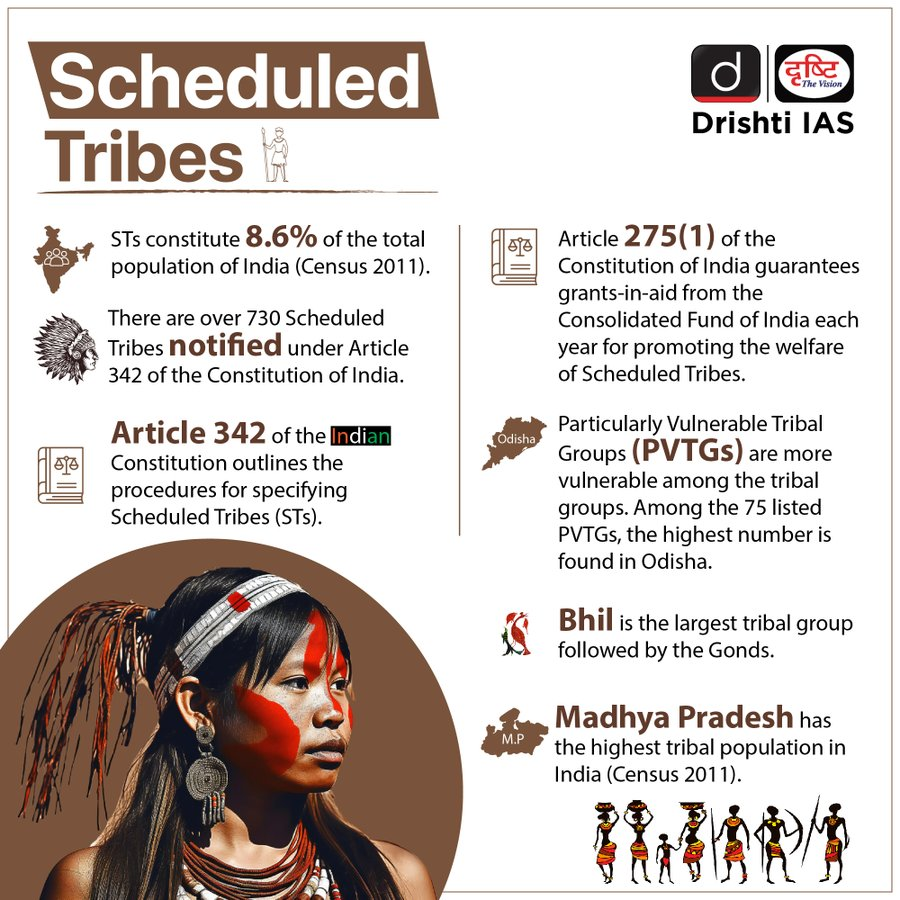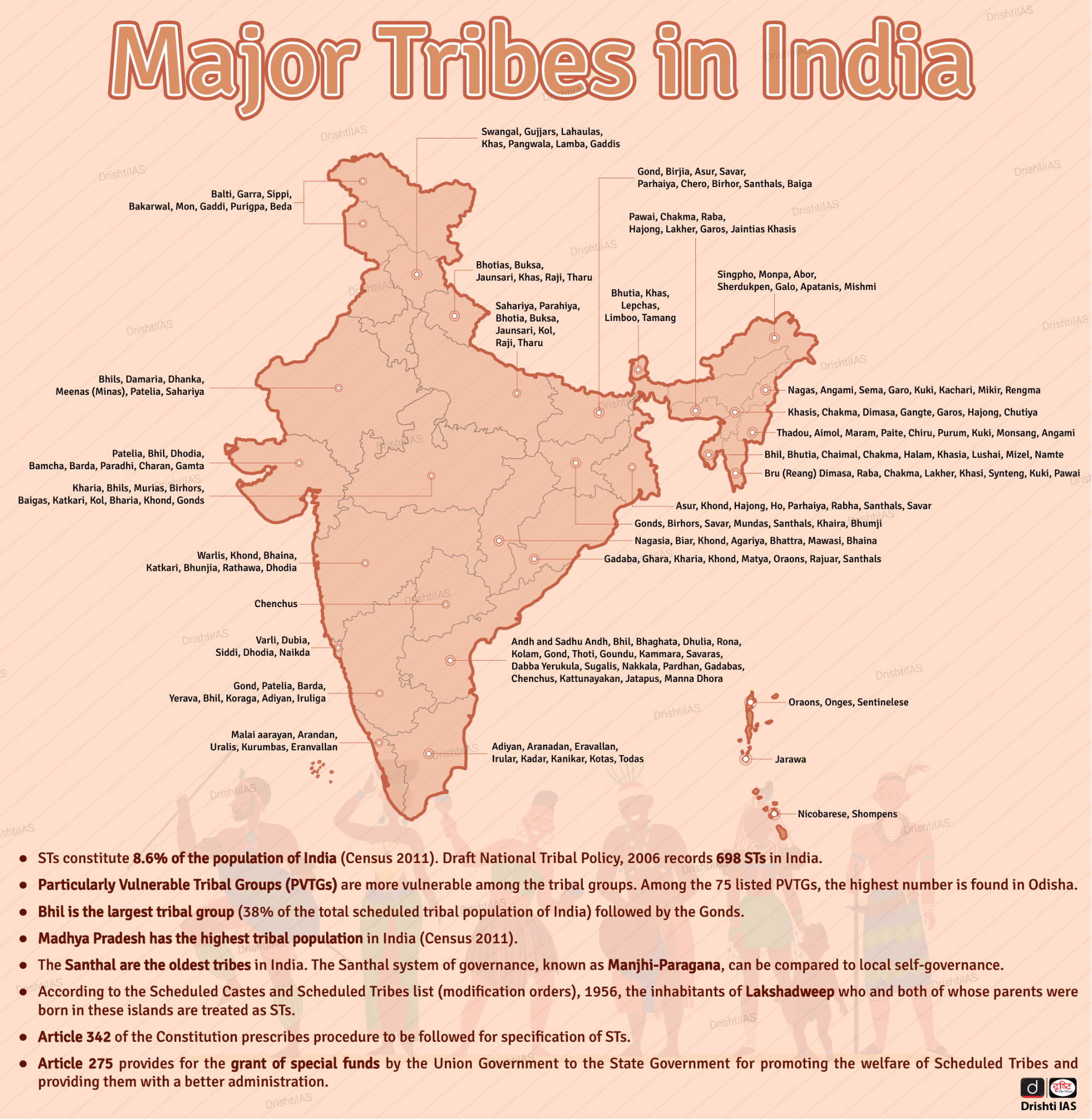Governance
Livelihood Promotion Among Tribals
- 09 Nov 2024
- 8 min read
For Prelims: Multidimensional Poverty Index (MPI), National Food Security Act, 2013 (NFSA), National Family Health Survey (NFHS-5) 2019-21, Stunting, Wasting, Underweight, Subsistence Farming, International Fund for Agricultural Development, Odisha Tribal Development Project (OTDP), UNICEF, World Food Programme, Community Forest Rights (CFR), Tribal Cooperative Marketing Development Federation of India (TRIFED), PDS, Microfinance, Local Governance Bodies.
For Mains: Challenges associated with livelihood of tribals. Measures needed for tribal livelihood promotion.
Why in News?
The recent Mango kernel consumption deaths in Odisha's Kandhamal district highlight a severe livelihood crisis among tribal communities.
- Mango kernels, the seeds left after juice extraction, contain cyanogenic glycosides like amygdalin, which release toxic hydrogen cyanide when consumed.
Why Tribals Rely on Unsafe Consumption for Livelihood?
- Severe Poverty: Tribal communities depend on wild and foraged foods mainly because of widespread and long-standing poverty.
- According to the global Multidimensional Poverty Index (MPI), 65 million of the 129 million tribals are living in multidimensional poverty.
- Food Insecurity: The geographical isolation, inadequate infrastructure, and logistical challenges have made it difficult for tribal communities to access regular, nutritious food supplies under National Food Security Act, 2013 (NFSA).
- Malnutrition: Many tribal families do not have enough access to food staples like grains, pulses, oils, or fortified items.
- As per the National Family Health Survey (NFHS-5) 2019-21 report, the prevalence of stunting, wasting and underweight among tribal children stands at 40.9%, 23.2% and 39.5% respectively.
- Lack of Forest Rights: Tribals have historically relied on forests for their livelihoods, gathering wild foods, and subsistence farming.
- However, displacement, deforestation, loss of forest rights, and restricted access to land pushed them into extreme poverty.
- Economic Exploitation: Some tribals are forced to resort to mortgaging their welfare cards (e.g., ration cards) to local moneylenders in exchange for short-term debt relief.
- These exploitative practices often deprive the rightful recipients of government benefits, forcing them further into debt.
- Survival in Extreme Conditions: During periods of extreme poverty, food scarcity, and seasonal droughts, tribal families are forced to rely on unsafe food sources to survive amidst worsening socio-economic conditions.
- Insufficient Institutional Support: The impact of International Fund for Agricultural Development-supported Odisha Tribal Development Project (OTDP), UNICEF’s Household Food Security Project in vulnerable blocks, and the World Food Programme's community-based anti-hunger projects in remote tribal areas has been limited.
What are Government Initiatives for Tribals?
How can Livelihood of Tribals be Improved?
- PDS Innovations: Expanding the system to include essential nutritious staples (e.g., pulses, oils) can help bridge the nutrition gap in marginalised tribal communities.
- Door-to-door delivery of PDS rations ensures that remote communities have consistent access to vital food supplies.
- Enhanced Access to CFR: Enhanced Access to Community Forest Rights (CFR) allows tribes to exercise control over forest resources, promoting sustainable harvesting of minor forest produce (MFP).
- Fair Market Prices: Ensuring that tribal communities receive fair prices for MFPs, like honey, tamarind, wild mushrooms, and mango kernels, is crucial for economic self-reliance.
- Government initiatives, particularly those supported by organisations like the Tribal Cooperative Marketing Development Federation of India (TRIFED), can facilitate market access by connecting tribal producers to larger markets, ensuring fair compensation.
- Financial Protection: Regulating microfinance practices to prevent predatory lending can protect tribal communities from exploitative loans and debt cycles.
- Leveraging Past Lessons: Reflecting on the successes and shortcomings of past initiatives (e.g., OTDP, PDS innovations) is essential to refine future approaches and build on effective strategies.
- Strategic Partnerships: Collaborative efforts between district administrations, local governance bodies, non-profits, and civil society organisations are vital for building community resilience.
- Value Addition: Promoting the processing of MFPs, such as converting mango kernels into valuable products for confectionery, cosmetics, and pharmaceuticals, can provide tribal communities with diverse income streams.
Conclusion
The recent deaths from mango kernel consumption in Odisha underscore the severe livelihood crisis among tribal communities, driven by poverty, food insecurity, and economic exploitation. Strengthening forest rights, enhancing market access, fair pricing for minor forest produce, targeted government initiatives, and strategic partnerships can collectively uplift and empower tribal populations sustainably.
|
Drishti Mains Question: Q. Discuss the factors contributing to the food insecurity crisis among India's tribal communities |
UPSC Civil Services Examination, Previous Year Question (PYQ)
Prelims
Q. At the national level, which ministry is the nodal agency to ensure effective implementation of the Scheduled Tribes and Other Traditional Forest Dwellers (Recognition of Forest Rights) Act, 2006?
(a) Ministry of Environment, Forest and Climate Change
(b) Ministry of Panchayati Raj
(c) Ministry of Rural Development
(d) Ministry of Tribal Affairs
Ans: (d)
Q. Consider the following statements about Particularly Vulnerable Tribal Groups (PVTGs) in India: (2019)
- PVTGs reside in 18 States and one Union Territory.
- A stagnant or declining population is one of the criteria for determining PVTG status.
- There are 95 PVTGs officially notified in the country so far.
- Irular and Konda Reddi tribes are included in the list of PVTGs.
Which of the statements given above are correct?
(a) 1, 2 and 3
(b) 2, 3 and 4
(c) 1, 2 and 4
(d) 1, 3 and 4
Ans: (c)
Mains
Q. What are the two major legal initiatives by the State since Independence addressing discrimination against Scheduled Tribes (STs)? (2017)
Q. Why are the tribals in India referred to as ‘the Scheduled Tribes’? Indicate the major provisions enshrined in the Constitution of India for their upliftment. (2016)








